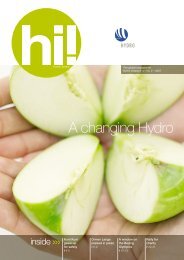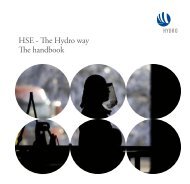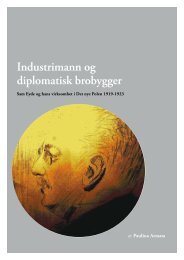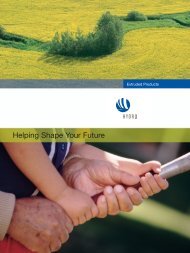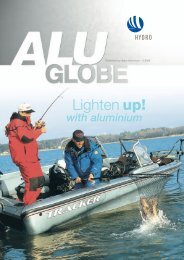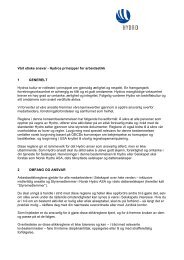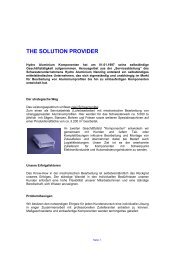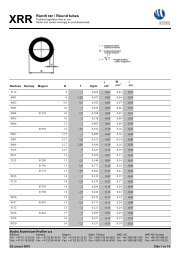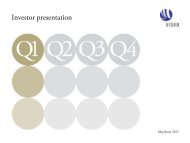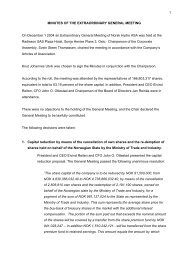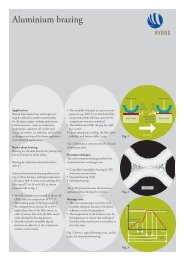Hydro Annual Report 2011b
Hydro Annual Report 2011b
Hydro Annual Report 2011b
Create successful ePaper yourself
Turn your PDF publications into a flip-book with our unique Google optimized e-Paper software.
In 2011, we established an electronic tool named Scrap Portal<br />
to raise competence and efficiency within the organization.<br />
Most remelters are using the portal for all scrap procurement.<br />
The portal is also used to coordinate scrap collection with customer<br />
deliveries. We have planned to finalize the development<br />
of generating management reports that look at various aspects<br />
of our scrap buying in March 2012.<br />
In the area of recycling, we have lifted our budgets even further<br />
as a joint effort between our Metal Markets, Rolled Products<br />
and Extruded Products business areas. This includes funding<br />
for projects related to closed-loop recycling of downstream<br />
products, recycling-friendly alloys and products, upgraded<br />
scrap processing, and furnace technologies that help improve<br />
recycling rates and quality of scrap and metal produced. The<br />
scope of all our recycling-related projects also includes reduction<br />
of total waste and waste sent to landfill. <strong>Hydro</strong> participates<br />
in national and EU-funded projects to support our<br />
ambition as a company and industry.<br />
<strong>Hydro</strong> has embarked on an extensive R&D program to develop<br />
post-consumer scrap-recycling technology following market<br />
demand for products with a low carbon footprint. The R&D<br />
program includes joint projects with external research institutes<br />
such as SINTEf and NTNU in Norway, and RWTH Aachen<br />
in Germany. In 2012, we expect to finalize some projects to<br />
prepare for investments in specific recycling plants.<br />
We also engage in other joint projects. One project is funded<br />
by Norsk forskningsråd: the AlEnergy project on Mass flow<br />
Analysis (MfA), blending tools and melting/refining technology<br />
together with NTNU and SINTEf. There are four BMBf<br />
(German federal Ministry of Research and Education) funded<br />
projects, one with CUTEC in Clausthal-Zellerfeld on SPL<br />
inertization for alternative fuel usage, and three with RWTH<br />
Aachen, covering bio-fuels, alloy recycling and aluminium<br />
recovery from incinerator ashes. Another project with RWTH<br />
Aachen on salt optimization recieves funds from the German<br />
Industrial Research Comittee AIf (Arbeitsgemeinschaft industrieller<br />
forschung).<br />
In Norway we receive support from several public institutions<br />
to further develop our smelter and casthouse technology as<br />
well as downstream activities. These include Enova, The<br />
Research Council of Norway and Innovation Norway. In<br />
2011, we received approximately NOK 42 million from these<br />
institutions, while we were granted NOK 190 million to be<br />
paid out in the years to come if certain projects are implemented,<br />
see also page 52.<br />
Product development<br />
Implementing and commercializing innovative product ideas<br />
and concepts are core activities. Innovation often takes place in<br />
joint projects with the customer once needs have been identified.<br />
Numerous new products are launched every year.<br />
vIABIlItY perForMAnCe<br />
Innovation<br />
69<br />
The carbon footprint of our solutions is gaining increasing<br />
attention and relevance, especially when looking at new applications<br />
of aluminium and when improving the ecological performance<br />
of existing ones. Our approach to involve customers<br />
and key stakeholders in developing better solutions helps us to<br />
differentiate and become the partner of choice. for example,<br />
our Rolled Products business area works with packaging manufacturers<br />
to improve certain packaging material, to provide<br />
high functionality while improving recycling rates.<br />
We also work closely with customers to develop products that<br />
save energy and reduce emissions. Aluminium façades can<br />
lower operating costs and help enable buildings to produce as<br />
much energy as they consume during operation. We have constructed<br />
three such buildings in <strong>Hydro</strong>, in Germany, france<br />
and India. Heat pumps, integrated photovoltaic systems and<br />
intelligent building design all contribute to energy neutrality.<br />
By bringing our building systems operation’s R&D team closer<br />
to product development, we plan to increase sharing and<br />
thereby strengthen the Domal, Wicona, Technal and Alumafel<br />
brand centers, and to increase the speed-to-market of new<br />
products. This includes utilizing competence from our India<br />
unit, where craftsmen come closer to our brands’ range of specialty<br />
products and systems, working mode and overall product<br />
offer. In fact, the operation’s six locations in Europe and<br />
one in India work as if they were in the same location. In addition<br />
to the technical specifications of the products, delivery<br />
time is an important competitive factor. A separate KPI has<br />
been introduced to reduce the elapsed time from project to<br />
product to customer delivery.<br />
Through our Rolled Products business area, we have a strategic<br />
research partnership with the University of Aachen in Germany,<br />
aiming at modeling the entire rolling process chain. An<br />
example of Rolled Products’ innovations in 2011 is the development<br />
of a high-strength alloy that can contain 80-90 percent<br />
of heat exchanger-clad production scrap. The new alloy<br />
has been cast and rolled for seam welding, and the first trial<br />
orders for the automotive industry have been produced.<br />
HyGROSAL is a special aluminium coating that makes rotary<br />
heat exchangers more efficient by allowing a combined transfer<br />
of heat and mass. As a result, less energy is required for e.g. air<br />
conditioning and cooling of industrial buildings and sports<br />
arenas.<br />
Best practice sharing<br />
We strive toward business excellence through continuous<br />
improvement, utilizing people, technology and systems to be<br />
able to generate maximum value for our customers. Through<br />
decentralized power and responsibility, decisions are made by<br />
those best able to take them. Our business systems define the<br />
underlying principles needed to create a performance culture in<br />
a unit. One example is our Aluminium Metal Production System<br />
(AMPS), which is our best practice system and standard for



